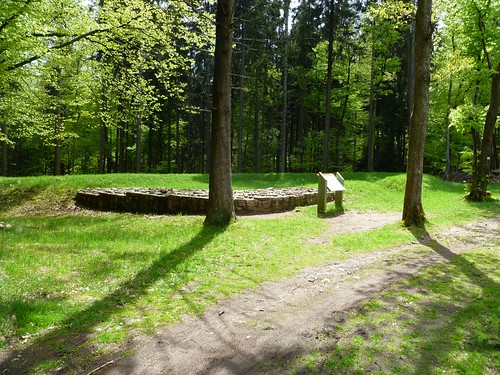The weather forecast did not look too promising for our last day walking, the culmination of our trip as we aimed to reach our finishing point at Saalburg. We returned to Kleinkastell Meisel, finding it hiding within its copse, and continued our journey eastwards. The Limesweg, after a minor zigzag, heads up to Glashütten, where an explosion of information is contained within the modestly named Limespavilion.

On we go, along the valley that once housed a thriving glass-making industry in the 15th and 16th centuries, and then up, up, up to Rotes Kreuz, a pass through the Taunus for a medieval (and probably earlier) road through the Limes. Soon after we came across the remains of Kastell Feldberg, beautifully presented, were it not for the small tractor cutting (perhaps massacring would be a better word) the grass in the pouring rain. With sundry internal buildings, including an apsidal principia sacellum, and four single-portal gateways, as well as an external bath-house, it is well worth a visit. We carried on climbing gently, before descending to Sandplacken for lunch; a fine stretch of bank and ditch can be seen here, as can WT 3/54 perched precariously on the roadside verge. Remarkably, that busy old fool, the unruly sun, had begun to put in occasional appearances.

After lunch we headed off once more, taking in the remains of a rather hirsute Kleinkastell Altes Jagdhaus (which, unsurprisingly, had the remains of an old hunting lodge inside it) and a contrastingly manicured Kleinkastell Heidenstock before we began a long, 3km descent to Saalburg. The sun, thankfully, was out as we arrived at the end of our 105-mile odyssey.

Saalburg itself looked better than when I last saw it, freed of the renovators’ scaffolding and decidedly spruced up. The only down side was that construction work in the fabrica (oh, the irony!) meant it was not accessible. The intermittent rain showed off the eavesdrips to advantage, whilst the principia cross-hall was, as ever, breathtaking. We ate in the taberna before taking our leave of Saalburg and the Obergermanische-Raetische Limes … for the time being.

 The notion that the Romans used speaking tubes to communicate along the Wall can be traced back to at least Drayton in the 17th century and his poem called the Polyolbion where his personified Wall mentions
The notion that the Romans used speaking tubes to communicate along the Wall can be traced back to at least Drayton in the 17th century and his poem called the Polyolbion where his personified Wall mentions















You must be logged in to post a comment.